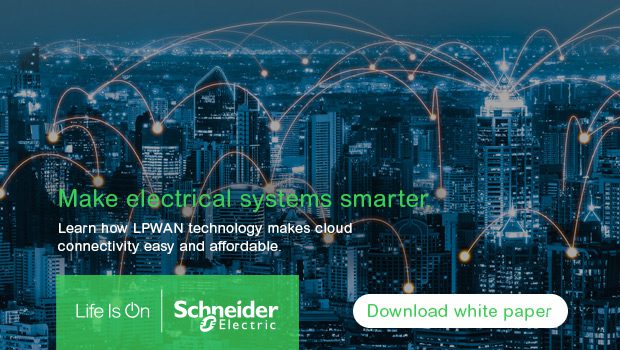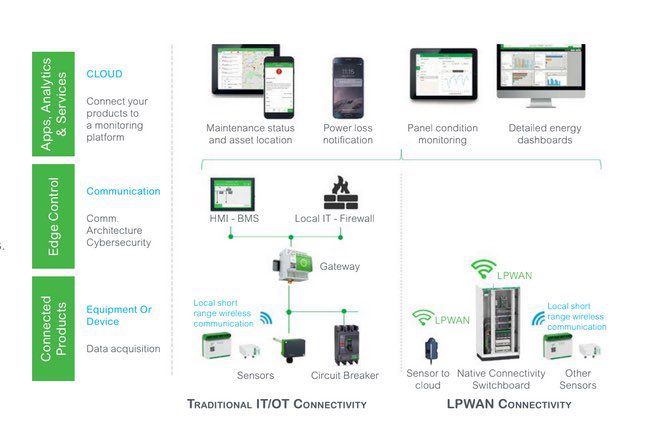According to Fortune Business Insights, the global Internet of Things (IoT) market size is projected to reach USD 1.4 trillion by 2027, exhibiting a CAGR of 24.9% over the 2019 to 2017 forecast period. Most of these devices IoT devices are connected to the cloud. Cloud connectivity reduces the need for in-person maintenance of local equipment through remote monitoring, cuts operational costs by deploying inexpensive third-party cloud-based services, and offers 24/7 access to data. Despite the ubiquitous presence of the cloud across businesses, only a small percentage of building owners have connected their power distribution equipment to the cloud to enable remote monitoring.
Why? One reason is that technology has moved at a speed that outpaces the rate of internal project deployments. Many businesses still perceive the connectivity of in-building power distribution systems as expensive and complex. Fears such as high capital expenditure (the belief that systems need to be hard-wired), and a need to enlist the services of overbooked IT network teams or high-priced specialists are no longer valid.
When paired with communications solutions based on low-power, wide-area network (LPWAN) technologies, new “smart” power distribution systems embedded with wireless IoT sensors, data communication infrastructure, and cybersecurity make quick, secure, and inexpensive access to the cloud a reality for building owners.

LPWAN and the role it plays in power distribution equipment monitoring
LPWAN is a technology that offers long-range wireless telecommunication at a low bit rate. This enables connectivity across commercial buildings and even multiple building campuses. This capability allows for the placement of sensors within electrical distribution equipment and switchboards. This then links directly to the cloud for easy analysis using LPWAN connectivity.
The multiple advantages of deploying LPWAN and the accompanying connectivity include:
- Low Cost – Because of the wireless aspects of LPWAN, the installation cost is much lower than traditional wired solutions. Network data transfer costs are also up to 10 x less expensive than 4G. LPWAN is based on open standards and can easily integrate and interoperate across multiple brands and technologies that reduce the expense of long and complex system integration and project coordination work.
- Remote access to building electrical distribution assets – The ability to remotely monitor smart meters, HVAC, electrical, lighting, and other energy-consuming assets within buildings using mobile devices means that technicians don’t have to be sent on-site as much. This helps to promote physical distancing and boosts productivity by allowing multiple sites to be monitored by one individual.
- A range that enables deep penetration within a building – Building infrastructure density plays a significant factor in helping to define level-of-service availability LPWAN offers a good compromise regarding communication range and deep indoor penetration, should users choose to install electrical equipment in a deep basement area, for instance.
- Reduced maintenance cost – Working with real-time data, maintenance managers and facilities personnel can more quickly make the right power distribution decisions. The cloud-driven ability to perform predictive analytics helps to further evolve smart building operations, resulting in optimized maintenance, reduced unscheduled downtime, and lower overall support costs.
- Native connectivity in power distribution system components – Electrical infrastructure manufacturers, like Schneider Electric, now pre-build native cloud connectivity capabilities into most of their electrical equipment. Those connection components can be simply activated through a service request whenever the end user needs to connect to the cloud. No need to engage technical experts from IT teams to help in pushing data through an IP network.
Consulting engineers play a key role in smart electrical distribution expansion
With these technological breakthroughs, consulting engineers are now more cognizant of building owners’ willingness to pay for these types of functions to digitize and future-proof their building operations. However, when deploying an LPWAN approach, there are restrictions on the communication “pipe” capacity. For instance, data transport volumes are not comparable to the broadband capacities of 4G communications. Thus, the quantity of data that can be uploaded and/or downloaded is limited.
However, within the realm of a building’s electrical distribution equipment, sending back and forth large quantities of data is not necessary. Alarming, temperature, and energy consumption data, sent along at preset time intervals, does not consume much bandwidth. This makes the LPWAN pipe sufficient to accomplish the goals of remote monitoring, data analysis, and predictive maintenance.
For owners of non-critical buildings (an office building vs. a data center or nuclear power control center, for example), LPWAN represents the optimal balance offering low cost while providing sufficient performance to achieve business continuity goals.

For more information
To learn more about how LPWAN can enable smart power distribution systems, download the new Schneider Electric white paper “How LPWAN Will Enable Massive Cloud Connectivity of Electrical Distribution Equipment.” This year, in a few selected countries, Schneider Electric is launching PrismaSeT Active, its first LPWAN-enabled switchboard. This switchboard will be a revolution to enable any customer, in any commercial building, to not only give their electrical distribution a voice, but to also optimize maintenance, save energy, and increase uptime.



